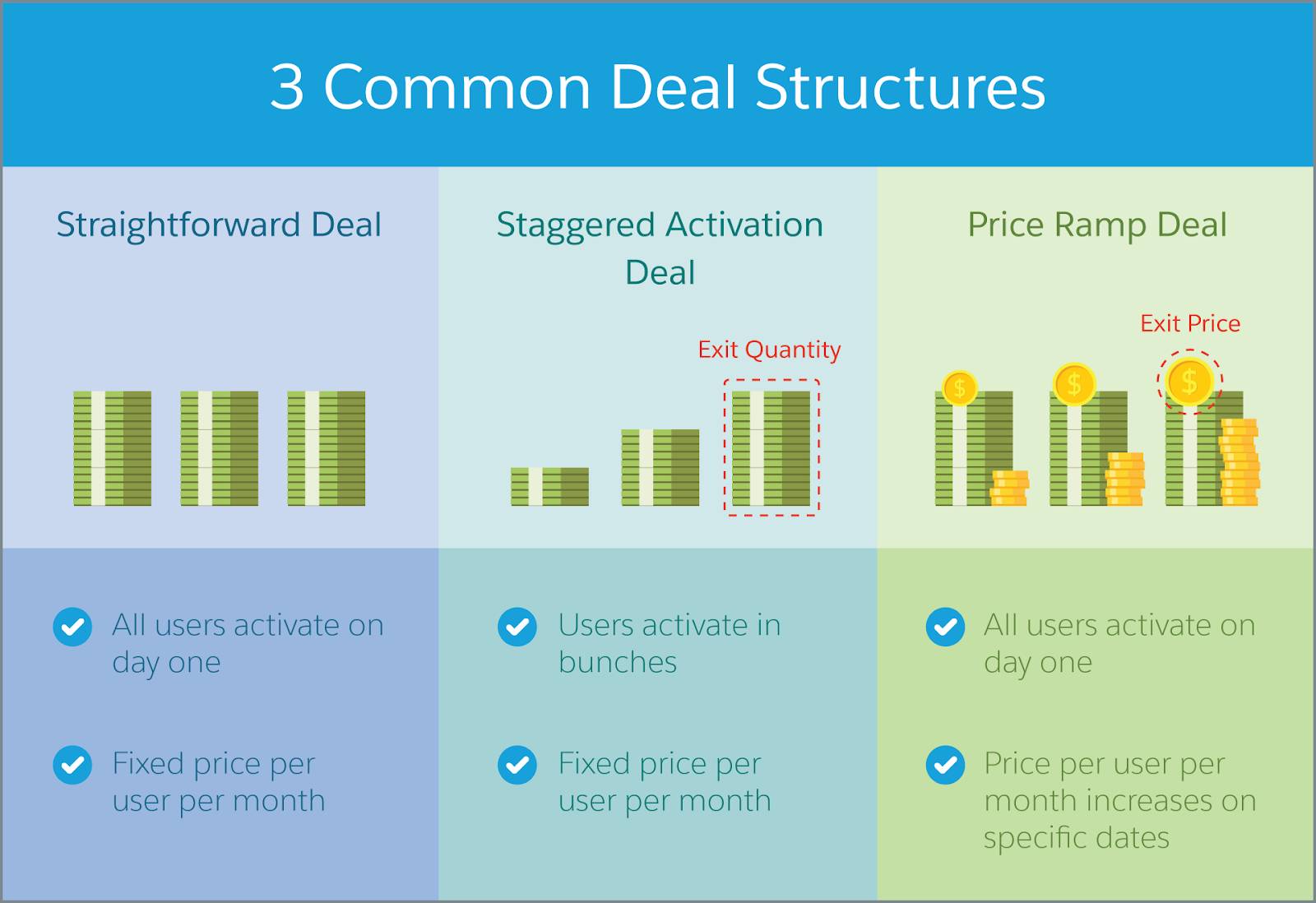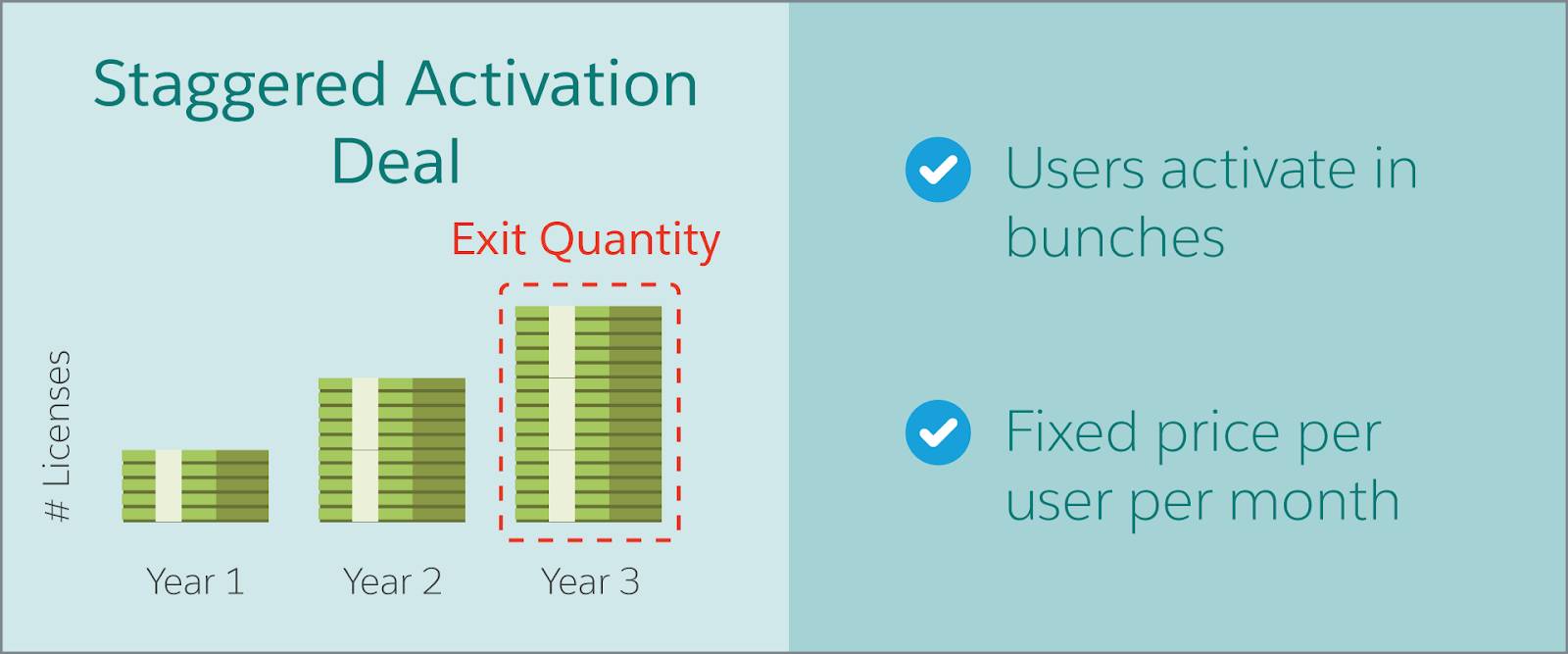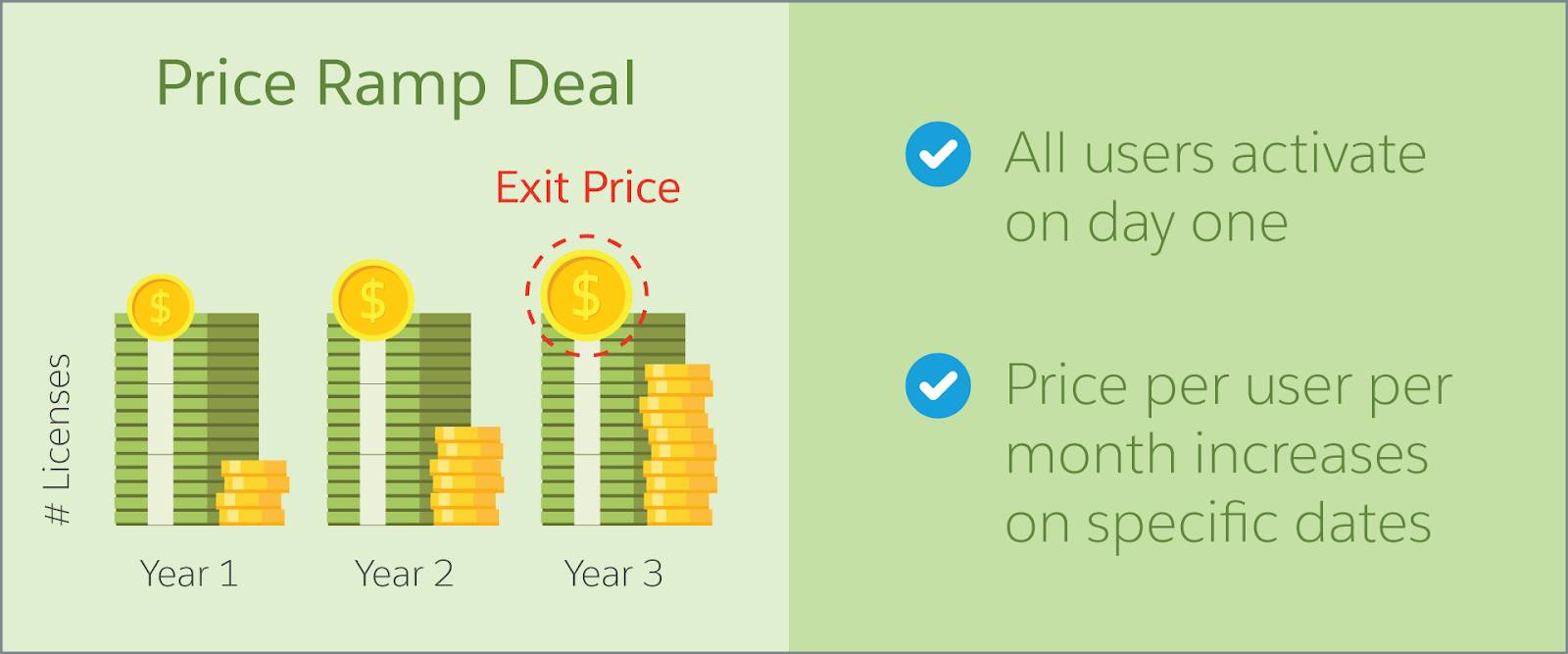Select Appropriate Sales Deal Structures
Learning Objectives
After completing this unit, you’ll be able to:
- Use the three most common sales deal structures.
- Explain advanced sales deal structures.
The Pros and Cons of Common Deal Structures
As you hone your Salesblazer skills, understanding and selecting your deal structures is an important skill to add to your toolbox. This unit takes you through pricing a sales deal–from selecting a deal structure to agreeing on terms with your customer.
Before we dig into this topic, let’s define some phrases.
| Term | Definition |
|---|---|
|
Deal Structure |
The terms that define a customer’s subscription to your products. Usually, this includes price, number of licenses, and duration of the contract. |
|
Exit year |
The final year of the contract. For example, in a 3-year deal, this would be the third year. |
|
Exit price |
The price of the subscriptions in the exit year. This is the most important number to you when assessing the price strength. |
|
Per user per month (PUPM) |
Price of a product for one user over a 1-month term. |
At Salesforce, we commonly use three structures to make deals: straightforward, staggered activation, and price ramp.
| Deal Structure | Definition |
|---|---|
|
Straightforward |
Customer buys a fixed number of licenses for a fixed period of time at a fixed price. |
|
Staggered activation |
Customer commits to a certain number of licenses, but they’re activated at different times–and paid for–in bunches, not all at once. |
|
Price ramp |
Customer buys a fixed number of licenses and the price they pay goes up over time. |
Let’s dive into the details of each deal structure, see examples of how we use them at Salesforce, and look at the pros and cons. (Our examples pertain to software licenses, but you can adapt these ideas to whatever you’re selling.)

The Straightforward Deal
The straightforward deal is, as you may have guessed, pretty straightforward. We can boil it down to this basic formula.
Price × Number of Users × Contract Term
Here’s some quick math. As an example, let’s say a Salesforce customer, Rad Unlimited, wants:
- Access for 1,000 users
- A 12-month contract
- The fixed price of $100 price per user per month (PUPM), based on a quantity of 1,000 users
- All users activated on day one
All we need to do is multiply PUPM × # of Users × Term.
$100 × 1,000 × 12 = $1,200,000.

There are no extra discounts, no staggered activations or price changes. The straightforward deal is by far the most favorable for a company because it maximizes annual contract value (ACV).
If possible, it’s a good idea to try to stick with the straightforward deal whenever you can by making it the starting point in conversations with your customers. But when customers are making large purchases and this structure doesn’t fit their needs, it’s time to look at one of the other deal structures.
The Staggered Activation Deal
With the staggered activation deal, the customer has the flexibility to add users in stages, instead of all at once. This keeps up-front costs down. From a Salesforce perspective, there are two keys to this type of deal.
- The customer must commit to a certain quantity of users during the exit year.
- Year one of the deal should include at least 50% of the exit-year users.
Staggered deals work well in the following circumstances.
- When a customer needs licenses for different groups of users at different times.
- When a customer is willing to commit, but only if they get preferential pricing that allows them to pay when licenses are needed.
- When a customer faces budget constraints in the first year or two of a multiyear deal.

Let’s walk through an example of a staggered activation, using the same customer, Rad Unlimited.
-
Customer Situation
- Rad Unlimited wants 1,000 total users over 3 years.
- The company doesn’t have the budget or need for full onboarding in years one and two.
- It’s concerned about the total contract value (TCV): It can’t spend more than $2.7M over the 3 years.
-
Contract Info
- Assume $100 price per user per month based on a quantity of 1,000 users.
- Deal starts with 500 users on day one (50% of total exit-year licenses).
- An additional 250 users added after 12 months.
- An additional 250 users are added after 24 months.
- Total users is 1,000.
-
Pricing Looks Like
- Year one: 500 users × $100 × 12 months = $600,000
- Year two: 750 users × $100 × 12 months = $900,000
- Year three 1,000 users × $100 × 12 months = $1,200,000
- Three–year total contract value = $2,700,000
Now, if this same 1,000–user contract had been structured as a straightforward deal, the pricing would have been:
- 1,000 users × $100/mo × 36 months = $3,600,000
- In this example, the customer saves almost a million dollars on the staggered deal by only paying for the licenses as they’re activated, according to the staggered activation dates they agreed to. The advantage for the company is getting a contractual commitment for the exit volume.
But staggered deals are not for every customer. Let’s take a look at the four criteria a company needs to meet for a staggered deal.
- The company knows which products and editions, and how many users the customer wants.
- The company knows, approximately, how the customer’s number of users will grow over time.
- The customer has demonstrated budget constraints in the first year or two.
- The customer agrees to phased rollouts with a fixed number of new users in each phase.
Predicting the future is anything but a sure bet and customers can’t always know how many licenses they’ll need a few years down the road.
While staggered activations include a customer commitment to a specific rollout, the customer can always bring users online ahead of schedule. We call that pulling licenses forward. When a customer pulls licenses forward, it starts paying for them right away and keeps paying through the rest of the contract term. In this scenario, a company’s ACV is preserved.
Another way that a company’s ACV is preserved is that customers can’t push license rollout back after it has committed. So, in exchange for giving the customer a price per user based on the total commitment, the customer is contracted to roll out by a certain date. If neither the straightforward nor the staggered structure is going to work for you and your customer, there’s a third common deal type to consider.
The Price Ramp Deal
The price ramp deal is the riskiest of the three structures for companies. Price ramp deals give the customer all of its products to users on day one, but at a low price in the initial period of the contract. As time goes on, the price increases, or ramps up, until it reaches full value–usually during the final year of the deal (or by year 3 in a 5-year deal). Customers ask for ramps so they can save money and get licenses early. And once a ramp is introduced into an account, the customer is likely to ask for it again for its next deal.
Price ramps can be good solutions for customers facing budget constraints in year one of a deal, when they have concerns over total contract value (TCV), or to pull a deal forward. While companies give up a little revenue in the first year or two of a price ramp, we’re bringing a new customer on board and ramping the customer to a good exit price. Year one of the deal should include more than 50% of the exit year average order value (AOV). The key is in aligning the price each year to a customer-verified rollout plan.
The use of a price ramp should fit into the overall strategy of the account, so before considering one, make sure all stakeholders are on board.

Now, let’s look at an example of how a price ramp deal would work with Rad Unlimited.
-
Customer Situation
- Rad Unlimited wants 1,000 total users over 3 years.
- It doesn’t need all 1,000 users right away and is concerned about the total contract value (TCV): The customer can’t spend more than $2.7M over the 3 years.
- Rad Unlimited is unsure about its exact timeline but is planning to have a rollout of all 1,000 users by the third year.
- It also sees value in having all the licenses up front for implementation testing.
-
Contract Info
- Assume $100 per user per month with an exit price based on a quantity of 1,000 users.
- Deal starts with all 1,000 users on day one.
- Price starts at $50 per user per month for all users on day one.
- Price increases for all users after 12 months to $75 per user per month.
- Price increases again for all users after 24 months to $100 per user per month, to reach exit price for all of 3 years.
-
Pricing Looks Like
- Year one: 1,000 users × $50 × 12 months = $600,000 (50% of exit year ACV)
- Year two: 1,000 users × $75 × 12 months = $900,000
- Year three: 1,000 users × $100 × 12 months = $1,200,000
- Three-year total contract value = $2,700,000
Again, that’s a lower TCV than the equivalent 1,000 user straightforward deal, which would total $3,600,000. In this case, Rad Unlimited does get to use the full 1,000 user subscription for all three years. So it’s a great deal for the customer, in many ways.
From a company standpoint, the key is that it has a new customer onboard and has ramped the deal up to a good exit price by year two or three. The goal is to renew the deal based on that exit price, and to add new users.
Here are criteria to consider when thinking about the price ramp deal structure.
- The company knows what products and editions your customer wants.
- The company is going to pull forward licenses early. (In other words, you get the customer to buy more licenses ahead of schedule.)
- Your customer has a limited year one budget or a limited total contract budget.
- Your customer has extended rollout periods with unknown demand in each stage.
A price ramp deal may work if all four criteria are met, but they are the least favorable of the three common structures, from an ACV perspective. It’s best to avoid making the price ramp your first suggestion.
Recap
Alright, we’ve covered the common deal types in-depth. But what happens when you have a structure in place, but your deal still needs a little tweaking before you can close? Let’s explore the give and get of negotiations in the next unit.